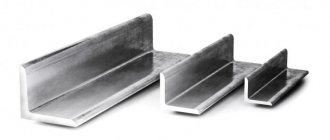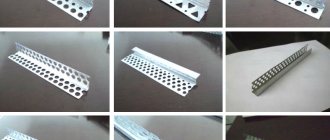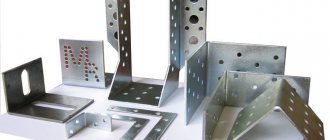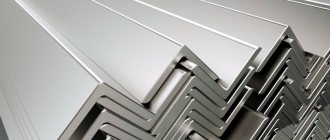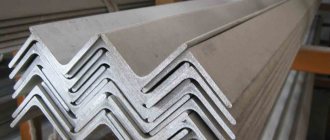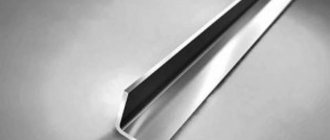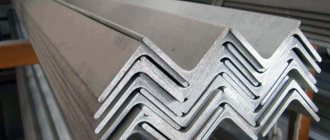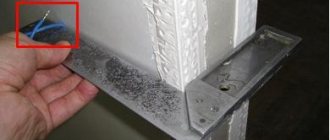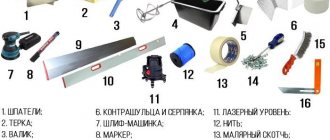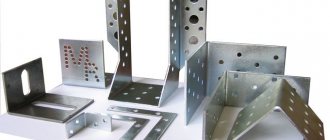An unequal steel angle is an L-shaped rolled metal profile, which is manufactured in accordance with GOST 8510-86.
The difference between such a corner and an equal angle corner is that its edges are different in width. For the manufacture of unequal angles, several types of steel are used, which meets the standards:
- Carbon steel (St0-St6, 09g2s, 3sp5 and others);
- Low alloy steel (08G2S, 12GS, 16GS).
Uneven angles are divided into two types, depending on the method of its production : hot-rolled and cold-formed . What is their difference? Hot rolled angles are made by hot rolling a steel billet between the rolls of a special rolling machine, and bent angles are made on roll forming machines by deforming a steel strip.
This difference can be easily noticed with the naked eye. If you pay attention to the outer corner. A hot-rolled angle will have a straight angle - 90 degrees, while a cold-formed angle will look rounded.
Steel for making unequal angles
Let's consider the grades of carbon steel that are most often used for the manufacture of steel unequal angles of standard accuracy:
- St0 - in such steel the amount of carbon is up to 0.23%, there are no restrictions in weldability, it is used for non-critical parts and secondary structures;
- St3kp - amount of carbon from 0.14 to 0.22%, with no restrictions on weldability, used for the production of elements of parts and structures under low load, the decoding of the letters “kp” shows its degree of deoxidation - boiling;
- St3sp - characteristics correspond to St3kp steel, the only difference is the degree of deoxidation - calm;
- St5ps - amount of carbon from 0.28% to 0.37%, used for the manufacture of rods, handles, nuts, bolts, all kinds of riveted structures, etc. Limited weldability. The degree of deoxidation is semi-calm.
In the manufacture of high-precision unequal angle angles from low-alloy steel, grade 09G2S steel is used.
Description, characteristics, accuracy class, assortment (GOCT 8510-86)
GOCT 8510 86 establishes the following size range of unequal corners (large shelf according to GOCT 8510 86 (feather) is designated B, small (butt) - b, shelf thickness - t):
- Minimum acceptable dimensions: B=25 mm, b=16 mm, t=3 mm (L25×16×3).
- Maximum dimensions: B=200 mm, b=125 mm, t=16 mm (L200×125×16).
According to the quality of rolled products, hot-rolled unequal flange angles are produced in two accuracy classes: A - high and B - normal. Accuracy classes determine the maximum deviations of nominal dimensions, radii of curvature and other geometric characteristics of rolled metal.
The number of the unequal angle is written as a fraction, where the first digit is the size of the large shelf in cm, and the second digit under the fractional line is the size of the small shelf in cm.
Hot-rolled unequal angles are manufactured from carbon steels (according to GOCT 535–88 and GOCT 380–94) or low-alloy (GOCT 19281-89). Examples of symbols:
- Angle No. 4.5/2.8 with shelf width B=45 mm, b=28 mm, thickness t=4 mm, high accuracy class B made of steel St3sp-1 GOCT 535-79):
- Angle No. 7.5/5 with shelf width H=75 mm, b=50 mm, thickness t=7 mm, high precision class made of low-alloy steel 09G2 according to GOCT 19281-89):
Documentation for the production of steel unequal angles
Basic documents for the production of steel angles:
- Regarding the material - GOST 535-88, GOST 380-94, GOST 19281-89.
- All standards for this type of rolled metal are shown for hot-rolled angles - GOST 8510-86, and for unequal bent angles - GOST 19772-93, or the standard valid within Ukraine - DSTU 2255-93.
The main and important characteristic of a steel unequal angle is strength. Its readings may change during cold hardening. This is a procedure for strengthening metal, which occurs due to plastic deformation.
When straightening rolled steel, where the flange thickness is 3-5 mm, as well as during other power work, it is necessary to take into account certain properties. If you produce a corner whose assortment does not meet GOST standards, cracking of the metal is often observed in the areas where the cold-hardening procedure was carried out. Thus, these structures do not have the proper safety margin, and therefore their service life is significantly reduced.
Characteristics described by GOST 8509-93
Fig.2. Regulated values of equal angles
The range of hot-rolled angles is determined by the following values:
- thickness and width of shelves;
- moment and radius of inertia;
- cross-sectional area of the profile;
- radii of internal curvature and shelf curvature;
- centrifugal moment of inertia;
- the size from the outer edge of the shelf to the center of gravity of the product.
Product numbers, their compliance with physical and technical parameters and the full range are indicated in the table below.
Table 1. Range and physical characteristics of equal-flange steel angles
All sizes and cross-sectional areas of hot-rolled steel angles are calculated based on actual dimensions, provided the metal density is at least 7.85 g/cm3.
Marking unequal angles
The dimensions of unequal angles are specified by quantities that are measured in millimeters:
- Width of the first shelf;
- Width of the second shelf;
- Shelf wall thickness.
The length of unequal corners ranges from 4 meters to 12 meters. The most commonly used corner sizes are 6 meters, 9 meters, 10 meters, 11.7 meters and 12 meters, but can be manufactured according to the individual customer order.
Depending on the length produced, steel unequal angles are classified:
- Measured length;
- Multiple measured length;
- Unmeasured length;
- Limited length within unmeasured.
And in terms of rolling accuracy:
- “A” - high accuracy;
- “B” - normal accuracy;
- "B" - increased accuracy.
Main technical characteristics of unequal corner:
- Very high level of rigidity;
- Quite light weight;
- Due to the special shape, the corner is able to withstand heavy loads.
Why do we need GOST standards for equal angles and other types of products?
Standardization of rolled metal products makes it possible to control their quality and dimensional characteristics. GOST helps determine the necessary geometric indicators, which are a very important component of construction calculations. For example, the range of equal-flange angles (GOST 8509-93) includes a complete list of dimensions and technical characteristics of these products. Let us dwell in more detail on the functions that GOSTs perform.
Metal corners are available in a wide range of sizes
Quality control. If you deviate from certain standards, a performance problem may arise. Therefore, the first and most important task of state standardization is quality control, which involves recording the parameters of these parts.
Note! The entire range of metal corners is made taking into account GOST standards and the maximum permissible deviations specified in them.
Simplification of notation. Metal parts of this type are available in a wide range of sizes. Without regulatory documentation, all information about quality characteristics would have to be indicated in the product labeling.
Quickly find the part you need. Tables of the assortment of equal angles and other varieties of these products are indicated in GOSTs and allow you to quickly find the desired element. Classification according to basic parameters greatly simplifies finding corners and introduces them to their properties.
The entire range of metal corners is made taking into account the relevant GOSTs
It is worth noting that this documentation contains more than 10 different characteristics, arranged in tables with appropriate symbols. In turn, in order to find the markings used, a special drawing is used. The cross-sectional diagram also makes it easier to find the required characteristics.
Application of steel unequal angles
Products of this type of rolled metal are often used in a wide variety of industries, as well as in households.
In construction, unequal angle angles are used for the construction of various rigid reinforcement structures, for raising lintels, in monolithic concreting, for reinforcing concrete, as well as for connecting various types of handrails. The corner is used both in private construction, for the construction of small objects, and for more serious objects. Products of such rolled metal products have gained popularity in the automotive industry, shipbuilding, carriage building, aircraft construction and even in interior design.
The unequal corner has also been used in the production of furniture and in interior decoration.
The only thing you should know when choosing a corner is that an unequal hot-rolled corner has higher strength characteristics than a cold-formed corner. Therefore, when using a corner in places where there will be a lot of physical activity, you should opt for a cold-formed unequal corner.
, offers a wide range of steel angles at reasonable prices, which can be found in the price list.
Gostov parameters of external angles and their sizes
The recommendations apply to both the corner at the top of the shelves and their outer corners. Standard 8509-93 allows blunting:
- profiles up to 10 mm thick - 0.3 shelf thickness;
- products with a thickness of 10-16 mm - 3.0 mm;
- corners with a thickness of more than 16 mm - 5.0 mm.
Subject to the recommendations of GOST, the calculation of operational characteristics is carried out according to the standard.
Table 5. Dimensions of equal flange hot-rolled steel angles according to ISO 657
Metal corner 50x50: characteristics and operational scope
Steel parts measuring 50x50 mm are the most popular type of corners. They belong to the group of equal-shelf products and are produced by rolling. The thickness of the shelves that are included in such rentals may vary. It is this indicator that determines the operational characteristics of steel parts.
Note! The thicker the corner, the higher its cost. This is easy to explain, since this value determines the amount of raw materials spent on the production of the product.
Thickness also affects the weight of the part. For example, a product whose given indicator is 4 mm weighs 3.05 kg (1 linear meter of a 50x50 part). The weight of 1 meter of a corner with a width of 5 mm will be 720 g more and amounts to 3.77 kg. The length of products belonging to the hot-rolled group reaches 12 m. If necessary, you can place an individual order by providing the executive organization with your own dimensions.
The maximum thickness of the shelves for these products is only 5 mm. Despite this fact, they have good density and high strength. The most common use of such corners is in furniture production. Due to their light weight, these products can be used to construct frames for cabinets and other interior items. The use of corners is determined by the fact that they help obtain ideal angles, which are so necessary when assembling furniture.
The thickness of the 50x50 steel angle shelves can be different
Products with similar dimensions are regulated by the relevant GOST. The range of equal angle angles allows you to select the necessary parts for different purposes. A corner with 50 mm shelves is used in the construction of various fences on playgrounds.
Main characteristics of corners: GOSTs and parameters specified in them
In the regulatory documentation that regulates steel angles, you can find all the useful information about them. Using the appropriate GOST, it will not be difficult to calculate the material required for the construction of frame structures of varying degrees of complexity. Let's consider the main characteristics that can be found in regulatory documents or calculated using them.
To carry out construction calculations, you will need to calculate the mass of the corners. Calculating the weight of one linear meter allows you to determine the load factor acting on the structure. This indicator depends on the type of product and its dimensions. The size of the corners is an important parameter, as it determines the performance of these products. Length, width, and wall thickness - all this data is taken into account during construction. It is also necessary to take into account the shape of the products.
Changing the thickness index affects the performance characteristics of the corner
Another parameter worth paying attention to is the cross-sectional area. This indicator helps determine the load factor. GOST for corners contains special tables that simplify the search for the necessary information.
Experts recommend paying attention to the radius of curvature of the metal product. Typically, this information is contained in the drawings. This value is not controlled, but it is necessary for calibrating parts.
All steel corners are divided into two types according to the shape of the shelves: equal-flange and unequal-flank. The tables that comply with the standards contain information about the thickness of the corners. GOST 8509-93, the assortment of which regulates equal-flanged products, as well as document 8510-93 (contains information on unequal-flanged angles) can be easily found on the Internet.
It is worth noting that changing the thickness index affects the performance characteristics of the parts. In this case, a certain pattern can be traced. The higher the thickness of the shelves, the stronger the corners themselves, which means the higher their resistance to stress.
Using the appropriate GOST, it will not be difficult to calculate the material required for the construction of frame structures
